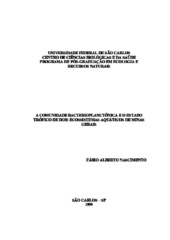| dc.contributor.author | Nascimento, Fabio Alberto | |
| dc.date.accessioned | 2016-06-02T19:31:41Z | |
| dc.date.available | 2009-07-20 | |
| dc.date.available | 2016-06-02T19:31:41Z | |
| dc.date.issued | 1999-04-08 | |
| dc.identifier.citation | NASCIMENTO, Fabio Alberto. Tha bacterioplaktonic community and the trophic state of ecosystems of Minas Gerais. 1999. 53 f. Dissertação (Mestrado em Ciências Biológicas) - Universidade Federal de São Carlos, São Carlos, 1999. | por |
| dc.identifier.uri | https://repositorio.ufscar.br/handle/ufscar/1944 | |
| dc.description.abstract | This work analyzed the density, biomass and bacterian biovolume through epifluorescency's microscopy with acridina's orange, they were related with the trophic state
of two aquatic ecosystem in Minas Gerais. The samples were colected in september 1995 (dry season) and february 1996 (rainy season) in the littoral and limnetic zone of Pampulha
reservoir, a eutrofized urban ecosystem, located at north region of Belo Horizonte city, strongly influenciated by the exhaust of the domestic and industrial sewers derived from of its tributaries and by the dumping of garbage by the population around, and in the Olhos d'Água lagoon, a natural urban ecosystem, oligotrophic, and little antropofically influenciated. Significantly differences were founded between physics, chemistry and biological varieties in that two environments. At Pampulha reservoir, the bacterian density oscillated from 0.31 x 106 bacteria/ml and 1.73 x 106 bacteria/ml in the drying season and between 0.31 x 106 and
1.15 x 106 bacteria/ml in the raining season. The biomass oscillated between 50.9 μgC/l and 279.9 μgC/l in the drying season and between 66.6 μgC/l and 205.2 μgC/l in the drying
season. The biovolume oscillated between 0.376 μm3/l and 0.644 μm3/l in the drying season and between 0.377 μm3/l and 0.667 μm3/l in the raining season. In the Olhos d'Água lagoon the density oscillated between 0.15x106 bacteria/ml and 0.19x106 bacteria/ml in the drying season. The biomass oscillated between 9.9 μgC/l and 44.70 μgC/l in the drying season and between 14.70 μgC/l and 28.33 μgC/l in the raining season. The biovolume oscillated between 0.151 μm3/l and 0.728 μm3/l in the drying season and between 0.221 μm3/l and 0.591 μm3/l in the raining season. These results suggest that there is a relationship between the bacterian community and the trophic state at the eutrophic environments where the bacterian community exists with higher results (density and biomass) due to major quantity of carbon available in the environment proceeding from the antropogenic actions. Studies about the quantity of (DOC) dissolved organic carbon, possible relationship among the bacterian and fitoplanktonic communities and predatories taxes of the picoplankton by the microzooplankton are needed at tropical environments to understand the bacterian dynamic in those environments. | eng |
| dc.format | application/pdf | por |
| dc.language | por | por |
| dc.publisher | Universidade Federal de São Carlos | por |
| dc.rights | Acesso Aberto | por |
| dc.subject | Ecologia aquática | por |
| dc.subject | Bacterioplâncton | por |
| dc.subject | Eutrofização | por |
| dc.subject | Lagos tropicais | por |
| dc.subject | Estado trófico | por |
| dc.subject | Limnologia | por |
| dc.title | A comunidade bacterioplanctônica e o estado trófico de dois ecossistemas aquáticos de Minas Gerais | por |
| dc.title.alternative | Tha bacterioplaktonic community and the trophic state of ecosystems of Minas Gerais | eng |
| dc.type | Dissertação | por |
| dc.contributor.advisor1 | Barbosa, Francisco Antonio Rodrigues | |
| dc.contributor.advisor1Lattes | http://buscatextual.cnpq.br/buscatextual/controladorbuscacv | por |
| dc.description.resumo | Densidade, biomassa e biovolume bacteriano foram analisados através da microscopia de epifluorescência, relacionando-os com o estado trófico de dois ecossistemas aquáticos de Minas Gerais. As amostras foram coletadas em setembro de 1995 (período de seca) e fevereiro de 1996 (período de chuvas) nas
regiões litorâneas e limnética da represa da Pampulha ecossistema urbano eutrofizado), e na Lagoa Olhos d Água (lago natural urbano, oligotrófico). Foram encontradas diferenças significativas entre as variáveis físicas, químicas e
biológicas nos dois ambientes. Na represa da Pampulha, a densidade bacteriana variou entre 0,30x106 bactérias/ml e 1,73x106 bactérias/ml no período de seca e entre 0,31x106 bactérias/ml e 1,15x106 bactérias/ml no período de chuvas. A
biomassa variou entre 50,9 μg C/l e 279,9 μg C/l no período de seca e entre 66,6 μg C?l e 205,2 μg C/l no período de chuvas. O biovolume variou entre 0,376 μm3 e 0,644 μm3 no período de seca e entre 0,377 μm3 e 0,667 μm3 no período de
chuvas. Na Lagoa Olhos d Água a densidade variou entre 0,15x106 bactérias/ml e 0,19x106 bactérias/ml no período de seca e entre 0,13x106 bactérias/ml e 0,22x106 bactérias/ml no período de chuvas. A biomassa variou entre 9,9 μg C/l e
44,7 μg C/l no período de seca e entre 14,7 μg C/l e 28,3 μg C/l no período de chuvas. O biovolume variou entre 0,151 μm3 e 0,728 μm3 no período de seca e entre 0,221 μm3 e 0,591 μm3 no período de chuvas. Esses resultados sugerem existir uma relação entre a comunidade bacteriana e o estado trófico em ambientes eutróficos onde a comunidade bacteriana se apresenta em números mais elevados (densidade e biomassa), devido a maior quantidade de carbono disponível no ambiente. Estudos acerca da quantidade de carbono orgânico dissolvido (COD) disponível no ambiente, possíveis relações entre as comunidades bacteriana e fitoplanctônica e taxa de predação do picoplâncton pelo protozooplâncton se fazem necessários em ambientes tropicais, para se entender a dinâmica bacteriana nesses ambientes. | por |
| dc.publisher.country | BR | por |
| dc.publisher.initials | UFSCar | por |
| dc.publisher.program | Programa de Pós-Graduação em Ecologia e Recursos Naturais - PPGERN | por |
| dc.subject.cnpq | CIENCIAS BIOLOGICAS::ECOLOGIA | por |
| dc.contributor.authorlattes | http://lattes.cnpq.br/2403483154296692 | por |
